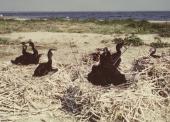
Cormorants form the family Phalacrocoracidae of the order Pelecaniformes. Like the pelicans, they have a completely webbed foot; they differ in having a much smaller throat pouch and dark or pied plumage. Of the approximately thirty species of cormorants in the world, the double-crested cormorant (Phalacrocorax auritus) is the only species found in Saskatchewan. They are most often found nesting on islands in association with other colonial nesting species such as pelicans, herons, gulls, and terns. They build their nests either on the ground or in trees. Cormorants will use and add to the same nest structure each year, with some of the nests reaching a height of 2 m or more. The cormorant is an opportunistic feeder that preys mostly on fish but will also eat invertebrates, crayfish, and salamanders. It dives underwater for its prey, propelled by its totipalmate feet (its four toes being connected by a web). A hook at the tip of the upper bill helps the cormorant grasp its prey. As the cormorant’s uropygial gland does not produce much water-proofing oil, after diving it will perch with wings outstretched in order to dry its feathers.
Cormorants were recorded for Saskatchewan in 1892. The population of the double-crested cormorant has been steadily increasing in the province since the late 1960s. Being fish-eaters, they are often persecuted by commercial and recreational fishermen.
Keith Roney